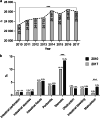Crohn's disease: a population-based study of surgery in the age of biological therapy
- PMID: 33876296
- PMCID: PMC8505365
- DOI: 10.1007/s00384-021-03930-w
Crohn's disease: a population-based study of surgery in the age of biological therapy
Abstract
Purpose: Despite primary conservative therapy for Crohn's disease, a considerable proportion of patients ultimately needs to undergo surgery. Presumably, due to the increased use of biologics, the number of surgeries might have decreased. This study aimed to delineate current case numbers and trends in surgery in the era of biological therapy for Crohn's disease.
Methods: Nationwide standardized hospital discharge data (diagnosis-related groups statistics) from 2010 to 2017 were used. All patients who were admitted as inpatient Crohn's disease cases in Germany were included. Time-related development of admission numbers, rate of surgery, morbidity, and mortality of inpatient Crohn's disease cases were analyzed.
Results: A total number of 201,165 Crohn's disease cases were included. Within the analyzed time period, the total number of hospital admissions increased by 10.6% (n = 23,301 vs. 26,069). While gender and age distribution remained comparable, patients with comorbidities such as stenosis formation (2010: 10.1%, 2017: 13.4%) or malnutrition (2010: 0.8%, 2017: 3.2%) were increasingly admitted. The total number of all analyzed operations for Crohn's disease increased by 7.5% (2010: n = 1567; 2017: n = 1694). On average, 6.8 ± 0.2% of all inpatient patients received ileocolonic resections. Procedures have increasingly been performed minimally invasive (2010: n = 353; 2017: n = 687). The number of postoperative complications remained low.
Conclusion: Despite the development of novel immunotherapeutics, the number of patients requiring surgery for Crohn's disease remains stable. Interestingly, patients have been increasingly hospitalized with stenosis and malnutrition. The trend towards more minimally invasive operations has not relevantly changed the rate of overall complications.
Keywords: Crohn’s disease; IBD; Immunotherapeutics; Surgery.
© 2021. The Author(s).
Conflict of interest statement
There are no financial and direct/indirect personal relationships to disclose in regard to the present study.
Figures




References
-
- Vulliemoz M, Brand S, Juillerat P, Mottet C, Ben-Horin S, Michetti P, on behalf of Swiss IBDnet, an official working group of the Swiss Society of Gastroenterology TNF-alpha blockers in inflammatory bowel diseases: practical recommendations and a user’s guide: an update. Digestion. 2020;101(Suppl 1):16–26. doi: 10.1159/000506898. - DOI - PubMed
-
- Misselwitz B, Juillerat P, Sulz MC, Siegmund B, Brand S, on behalf of Swiss IBDnet, an official working group of the Swiss Society of Gastroenterology Emerging treatment options in inflammatory bowel disease: janus kinases, stem cells, and more. Digestion. 2020;101(Suppl 1):69–82. doi: 10.1159/000507782. - DOI - PubMed
-
- Research data centres of the Federal Statistical Office and the statistical offices of the of the Federal States. Diagnosis-Related Group Statistics (DRG Statistics) 2010–2017, own calculations. 10.21242/23141.2010.00.00.1.1.0 to 10.21242/23141.2017.00.00.1.1.0
MeSH terms
LinkOut - more resources
Full Text Sources
Other Literature Sources
Medical

